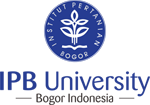ISSN-P: 1907-3933
ISSN-E: 2087-9059
Hosted and Managed by:
Collaborated with:
Indexed by:
Checked by:
Referenced by:
AUTHOR GUIDELINES
The Indonesian Landscape Journal (JLI) is edited by the editorial board of Department of Landscape Architecture, Faculty of Agriculture, IPB University in cooperation with the Indonesian Institute of Landscape Architects (IALI). The journal is published by the Department of Landscape Architecture of Faculty of Agriculture IPB University in April and October each year. The editor receives manuscripts in the field of Landscape Architecture related to aspects of planning and design, management and landscape plant as a major study.
Manuscripts are reviewed by the experts in accordance with the field of study. The manuscript reviewed is divided into categories of research, evaluation criticism, models, technology proposals, and reflection of thought. Invited paper is not reviewed and the composition of the writing does not follow the writing guidelines of this journal.
Template for Manuscript of JLI (right click and save as)
PROCEDURE
FORMAT
Book:
Simonds JO. 1983. Landscape Architecture. McGraw-Hill Book Co. New York.
Arifin HS, Kaswanto RL. 2023. Manajemen Ruang Terbuka Biru untuk Pengendali Banjir. IPB Press. Bogor.
Journal:
Arkham HS, Arifin HS, Kaswanto RL. 2014. Strategi Pengelolaan Lanskap Ruang Terbuka Biru di Daerah Aliran Sungai Ciliwung. Jurnal Lanskap Indonesia 6(1): 1-5. https://doi.org/10.29244/jli.v6i1.18125
Fitriana AF, Kaswanto RL, Nurhayati HSA. 2023. Strategi Manajemen Lanskap yang Dikembangkan pada Taman Kota di Kota Purwokerto. SPACE 10(2): 259-280. https://doi.org/10.24843/JRS.2023.v10.i02.p09
Proceeding:
Afiyanita H, Kaswanto RL. 2021. Evaluation of Urban Landscape Visual Quality based on Social Media Trends in Bogor City. IOP Conference Series: Earth and Environmental Science 622(1): 012022. IOP Publisihing. https://doi.org/10.1088/1755-1315/622/1/012022
Arifin HS, Nurhayati HSA, Kaswanto RL, Budiadi, Irwan SNR, Faisal B, Dahlan MZ, Nadhiroh SR, Wahyuni TS, Ali MS. 2021. Landscape Management Strategy of Pekarangan to Increase Community Immunity during the Covid-19 Pandemic in Java Indonesia–Inductive Research. IOP Conference Series: Earth and Environmental Science 918(1): 012029. IOP Publishing. https://doi.org/10.1088/1755-1315/918/1/012029
Rohadi PP, Qisthina N, Aulia R, Arifin HS, Kaswanto RL. 2024. Urban Landscape Management of Makassar City Based on Waterfront City Concept. IOP Conference Series: Earth and Environmental Science 1384(1): 01209. IOP Publisihing. https://doi.org/10.1088/1755-1315/1384/1/012029
Information from internet:
[KEMENPERA] Kementerian Negara Perumahan Rakyat. 2007. Rusunawa, Hunian Alternatif Untuk Kalangan Bawah. http://www.rusunawa.net (diakses 27 Jan 2010).
Publication Fee
JLI charges the following author fees. Since issue Vol. 16 No. 2 (2024) OCTOBER, Article Publication Cost (APC) in Jurnal Lanskap Indonesia is IDR 1.500.000,- (one million five hundred thousand rupiah).
Article Submission: 0.00 (IDR)
Authors are not required to pay an Article Submission Fee as part of the submission process to contribute to review costs.
Article Publication: IDR 1.500,000.00 (Indonesia Citizen) or USD 100 (Non-Indonesia Citizen)
If your paper is accepted for publication in JLI, you will be asked to pay an Article Publication Fee to cover publications costs.
This journal permits and encourages authors to post items submitted to the journal on personal websites or institutional repositories both prior to and after publication, while providing bibliographic details that credit, if applicable, its publication in this journal. However, after the article is submitted and published in this journal, it is fully copyrighted by the Jurnal Lanskap Indonesia or JLI. If excerpts from other copyrighted works are included, the author must obtain written permission from the copyright owner and give credit to the source in the article. Then, the writer or reader is allowed to copy, share, and redistribute articles/material in any form. But it must still include the appropriate source and credit because the article in this journal is licensed by Creative Commons Attribution 4.0 International License (CC BY 4.0).
Authors who publish with this journal agree to the following terms:
Authors who publish with this journal agree to the following terms:
The names and email addresses entered in this journal site will be used exclusively for the stated purposes of this journal and will not be made available for any other purpose or to any other party. This journal permits and encourages authors to post items submitted to the journal on personal websites or institutional repositories both prior to and after publication, while providing bibliographic details that credit, if applicable, its publication in this journal.
However, after the article is submitted and published in this journal, it is fully copyrighted by the Jurnal Lanskap Indonesia or JLI. If excerpts from other copyrighted works are included, the author must obtain written permission from the copyright owner and give credit to the source in the article. Then, the writer or reader is allowed to copy, share, and redistribute articles/material in any form. But it must still include the appropriate source and credit because the article in this journal is licensed by Creative Commons Attribution 4.0 International License (CC BY 4.0).
ISSN-P: 1907-3933
ISSN-E: 2087-9059
Hosted and Managed by:
Collaborated with:
Indexed by:
Checked by:
Referenced by:

This Journal is published under the terms of the Creative Commons Attribution 4.0 International License

Departement of Landscape Architecture
Faculty of Agriculture
IPB University
Jl. Meranti Kampus IPB Dramaga, Bogor 16680, West Java, Indonesia
Telp./Fax : +62-251-8422415
Email: landscapearch@ipb.ac.id / landscapearch@apps.ipb.ac.id
Website: http://arl.faperta.ipb.ac.id/
Instagram: @jli_arl
